The Sanctuary
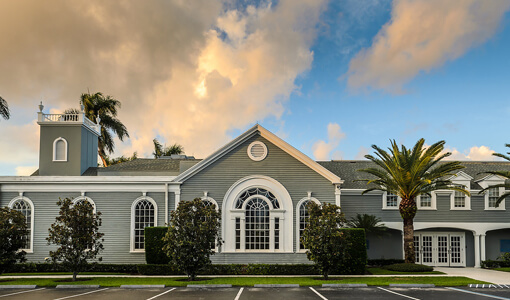
The following was derived from a 1991 letter and Designation Report from the Town of Palm Beach Planning, Zoning and Building Department and Landmarks Preservation Commission, and later cited in Sandra Thompson’s “God’s Church; Henry Flagler’s Legacy”:
“The original design (of the Chapel) took a form reminiscent of the colonial New England meetinghouse with two-tone white clapboard siding and a three-staged cupola/spire. The cupola/spire arrangement was flanked by a single-story veranda with hipped roof.
Patrons to the church would pass through a large aedicular entrance consisting of an arched opening rising up through a broken triangular pediment. Inside, the visitor found a cruciform plan with an envelope of light coming from the slender round-arched windows at either side of the nave. Grand ‘Palladian’ or ‘Venetian’ windows at the termination of the transept wings provided for an impressive source of light, flooding the body of the church.”
Although the main structure of the Chapel has been through many changes since its inception, worshipers will find a similar space to congregate as they did 120 years ago.
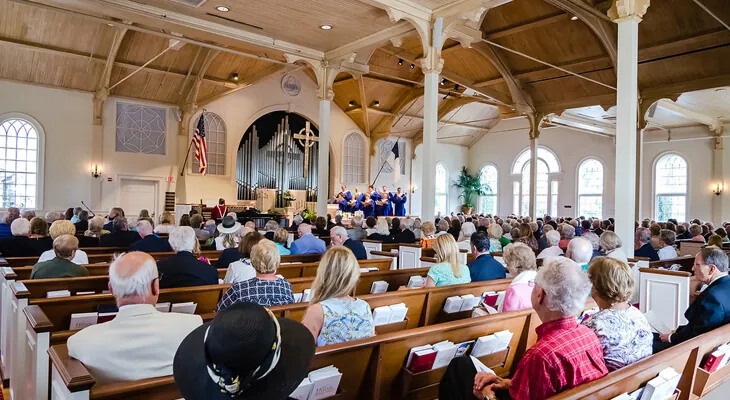
Sea Gull Cottage
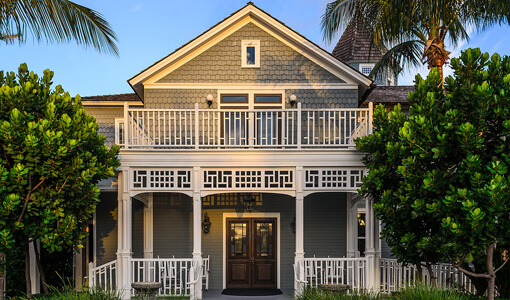
Historic Sea Gull Cottage, built in 1886, was known throughout the late 1880s and the 1890s as the “showplace along the shores” of Lake Worth. Built by R.R. McCormick, a Denver railroad and land developer, the house, a shingle-style cottage typical of Palm Beach’s earliest architecture, stood approximately 300 yards to the north of today’s Henry M. Flagler Museum.
Local residents in the pre-Flagler era remarked on the four distinctive features of Sea Gull Cottage, known then as McCormick’s Cottage. Those features were its sparkling stained glass, its magnificent mahogany staircase constructed from lumber salvaged from a local shipwreck, its cool Georgian marble entry-way floors, and its commanding third-story tower.
After seeing pictures of McCormick’s beautiful home in 1893, Flagler decided to purchase the lake-to-ocean tract and the house from McCormick for $75,000. Sea Gull, then known as Croton Cottage, became Flagler’s winter residence until the completion of his adjacent mansion, Whitehall, in 1902.
In 1913, Flagler moved Sea Gull Cottage from lakeside to the oceanfront. It became one of The Breakers Hotel rental cottages. It was on Breakers Row that it acquired the name Sea Gull Cottage.
When the aging and weathered structure was threatened with demolition in 1984, the Preservation Foundation of Palm Beach rescued it and had it relocated, again, across the island and restored near its original lakefront location on land provided by the Royal Poinciana Chapel.
Today, as the oldest existing house in Palm Beach, the Sea Gull Cottage serves the Chapel and the community of Palm Beach in varied and valuable ways.
In 2006, when initiatives in moving and restoring Sea Gull Cottage to Bradley Park were stalled, the Chapel Board of Directors determined that a retrofitted and expanded cottage would serve the Chapel’s needs for anticipated educational and community programs.
A working partnership with Preservation Foundation was reestablished. Architectural drawings were made by Jacqueline Albarran and SKA Associates.
The Chapel embarked upon a capital campaign to restore and expand Sea Gull Cottage and to do necessary exterior and interior refurbishments that include fully replacing its aged and antiquated HVAC system. A new garden design will enhance the overall landscape including the area between the Chapel and the lake and surrounding the Chapel’s columbarium.
The project was launched in 2007 with much enthusiastic support from town officials and leaders, the Preservation Foundation of Palm Beach, Chapel neighbors and friends. The entire community is invited to attend and join in the celebration and anticipation, and the beginning of a new day for the Sea Gull Cottage as a well-suited and highly-utilized showplace along the shores.
Fellowship Hall
Fellowship Hall was dedicated as Kirkman Hall upon its completion in 1993. Today, it serves the church as a place of fellowship, faith, study and congregation. A highlight that occurs in Fellowship Hall is one that follows service on Sundays. Our Chapel’s Hospitality Committee hosts a beautiful buffet and coffee for worshipers to come together as neighbors in fellowship. We hope that you will join us after service on a Sunday or take part in one of the many wonderful programs that happens in this space.
The Chapel Garden
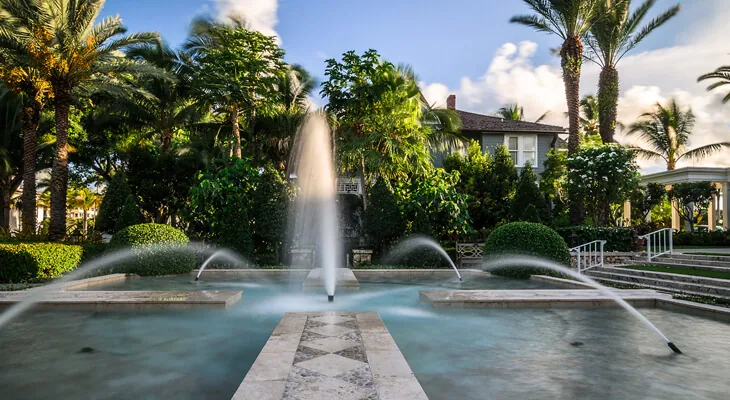
The Olivia and Walter Kiebach Memorial Garden: Dedicated – December, 2010
“Christianity is an out-of-doors religion. From the birth in the grotto at Bethlehem…to the crowning death on the hill of Calvary outside the city wall, all of its important events where God was most involved with humankind took place out-of-doors.” To look upon any special landscape where “the drama of humanity holds unforgettable memories” writes Henry Van Dyke is to be so blessed as “to walk quietly and humbly… in fellowship with those who long ago preceded and in anticipation of those who will for years to come follow in the Spirit union with the One who dwells within.
“In Christendom, there is a long tradition of beautiful cloistered gardens being connected to churches for meditation, contemplation and community enhancement.
“The Olivia Kiebach Memory Garden, the Great Lawn that includes the Historic Landmarked signature tree of Palm Beach, the Giant Kapok Tree, and the natural tranquil lakeside beauty of the Royal Poinciana Chapel grounds creates the most unique outdoor garden imaginable for corporate worship, personal meditation and multiple seasonal celebrations.”
– Dr. Bob Norris
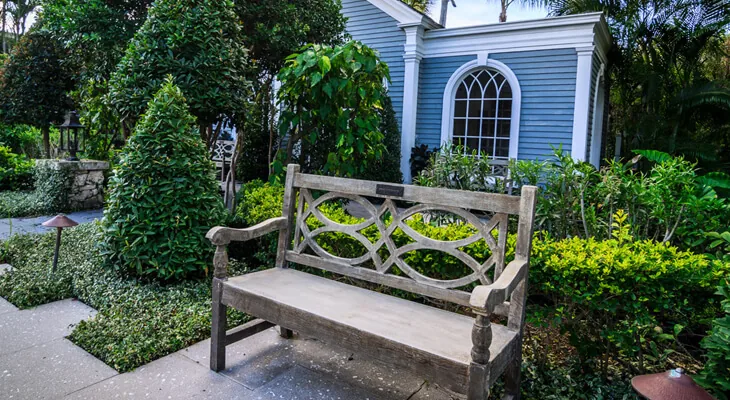
The Olivia and Walter Kiebach Memorial Garden and the Picotte Family Great Lawn lies between the Chapel and the Intracoastal Waterway.
This garden setting was envisioned in 2009 and completed and dedicated in December 2010 as a most beautiful, tranquil and unique setting in which to encounter God, either alone or with others.
The lovely garden surroundings will enhance the Chapel’s ministry by offering a dedicated and memorialized place for worship, columbarium committal services, Chapel celebrations, weddings, marriage vow renewals, personal quiet contemplation, and even active play space for children and youth for Chapel-sponsored programs that utilize the Great Lawn and the roots of the Grand Kapok Tree.
The Chapel garden incorporates a large tabby concrete patio expanding the loggia west of Kirkman Fellowship Hall. At the center axis of the garden is the Dudley Moore Family Fountain. Numerous garden rooms and seating areas offer dedicated benches that provide for quiet contemplation, conversational settings and spaces for spiritual reflection.
The lovely lush landscape of coconut palms and variegated greenery surrounding Seagull Cottage offer shade along a luscious, green, manicured Great lawn. The sea breeze and deep quiet are punctuated only by the rustle of palms fronds and the sounds of falling water and occasional meditative music.
The Chapel Board of Directors employed the talents of world renown and leading local Master Landscape Architect Mario Nievera to restore the Chapel garden’s earliest lush lakeside natural beauty which Henry Flagler first saw along the lake from which he decided to offer such a uniquely hospitable space to enjoy. We wish this to be a place where life will be celebrated, legacies left, memories pondered, and where blessings are offered and special celebrations occur.
